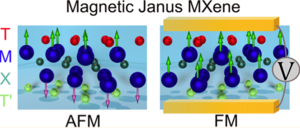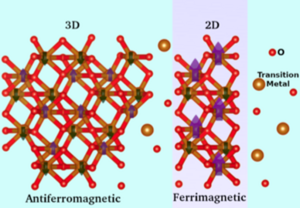Dr. Arkamita Bandyopadhyay

Fields of interest | 2D van der Waals magnetic materials Real-time spin dynamics |
| Publications | Google Scholar |
Research
My primary research interest encompasses electronic, magnetic, structural, optical and dynamical properties in a range of quantum systems. I am particularly interested in studying the molecular doping, atomic substitution or spin textures and their effects on the electronic, charge transfer and magnetic states of low dimensional systems. I intent to study the effect of surface, electric field and doping in the charge or electron transfer processes in complex heterogeneous van der Waals structures. Time dependent processes in complex systems for modulating optical properties can also be an interesting area of study in these layered materials.
Surface-engineered MXenes: Electric field control of magnetism and enhanced magnetic anisotropy

Controlling magnetism in 2D materials via electric fields and doping enables robust long-range order by providing an external mechanism to modulate magnetic exchange interactions and anisotropy. We predict that transition metal carbide and nitride MXenes are promising candidates for controllable magnetic 2D materials. The surface terminations introduced during synthesis act as chemical dopants that influence the electronic structure, enabling controllable magnetic order. We show ground-state magnetic ordering in Janus M2XOxF2−x (M - transition metal, X is C or N, and x = 0.5, 1, or 1.5) with asymmetric surface functionalization, where local structural and chemical disorder induces magnetic ordering in some systems that are non or weakly magnetic.
Engineering magnetic phases in two-dimensional non-van der Waals transition-metal oxides

The family of 2D magnetic materials is continuously expanding because of the rapid discovery of exfoliable van der Waals magnetic systems. Recently, the synthesis of non-van der Waals magnetic “hematene” from common iron ore has opened an unconventional route to 2D material discovery. These non-van der Waals 2D systems are chemically stable and easily available and may have different or enhanced properties compared to their van der Waals counterparts. In this work, we have investigated and explained the nature of magnetic ordering in non-van der Waals 2D metal oxides. Two-dimensional hematene is found to be fully oxygen-passivated and stable under ambient conditions. It exhibits a striped ferrimagnetic ground state with a small net magnetic moment. Superexchange interactions are predicted to control the magnetic ground state of hematene, where pressure-induced spin crossover results in an observable net magnetic moment. Modulating the superexchange by alloying hematenes alters the magnetic ordering, tuning the system to a ferromagnetic ground state. Extending this strategy to the design of a new 2D material, we propose 2D chromia (α-Cr2O3) or “chromene”, which, because of larger inter-transition metal distances and suppressed AFM superexchange, has a ferromagnetic ground state. We also show that tuning the magnetic ordering in these materials controls the transport properties by modulating the band gap, which may be of use in spintronic or catalytic applications.
